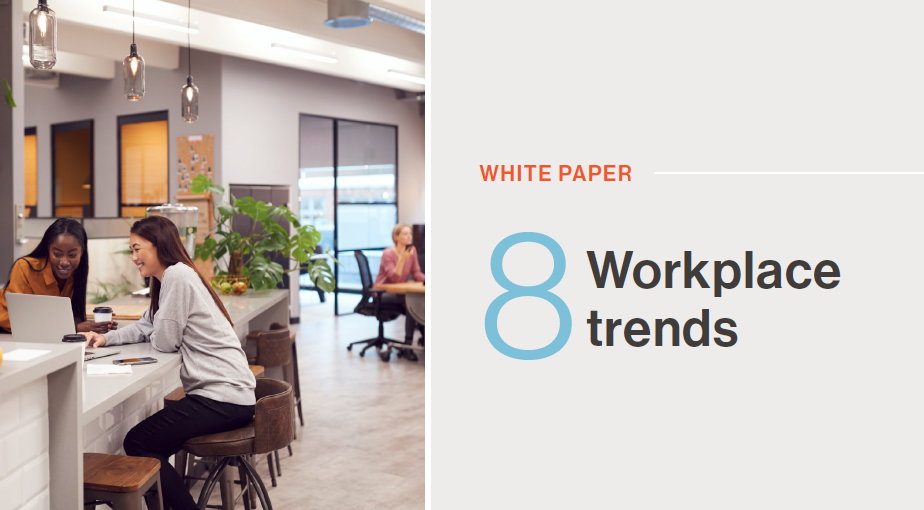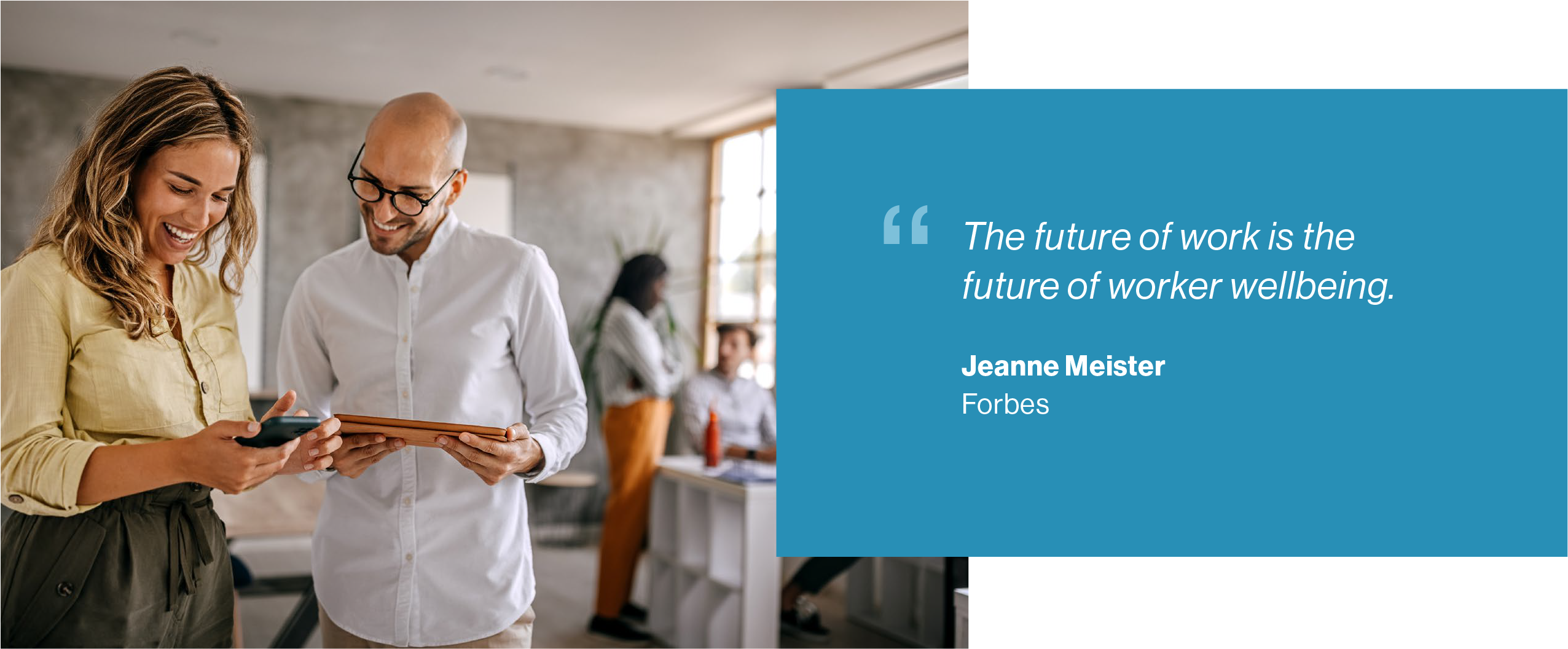8 Workplace Trends

The following 8 emerging workplace trends provide a host of benefits ranging from improved employee wellbeing to more innovation in the workplace—making them key to future-proofing any organization.
Create a better place for everyone.®

WHITE PAPER
8
8Workplace trends
()()OFFICESPACESOFTWARE.COM
()OFFICESPACESOFTWARE.COM
It’s never been more important to embrace workplace trends that keep employees happy and productive, while also supporting long term business goals and helping maximize the bottom line. The workplace is always changing—with or without global pandemics to contend with. As business leaders fight to stay competitive in an increasingly complex market, facility managers have to stay agile and ready to implement a variety of new tasks without sacrificing employee experience.
The following 8 emerging workplace trends provide a host of benefits ranging from improved employee wellbeing to more innovation in the workplace—making them key to future-proofing any organization.
1
Workers want true flexibility
While ‘hybrid work’ is the buzzword du jour, what employees are often seeking when talking about ‘hybrid’ is actually more flexibility. Up to 50% of workers say they’d quit or not accept a job offer from a company with too few flexible work options.1 Meanwhile, overall workplace experience scores jump from 45% to 74% when workers have more choice and freedom over when, where, and how they work.2
Given these numbers, it’s not surprising that beyond adopting hybrid, companies are also turning to new dynamic strategies that give employees more decision-making power over their work. Agile working, free addressing, activity-based working, and office neighborhoods all fit the bill, requiring FMs to keep up by finding and optimizing tailor-made tools to make them work as intended.

2
2 Workspace design is no longer ‘one-size-fits-all’
Workspace design today is all about creating offices that are designed around how they’ll actually be used, focusing on what employees need to be most productive. The days of endless cubicles may be out, but so too are large, open offices that don’t serve the people who use them.
In other words, sometimes employees need private spaces, sometimes they need ‘official’ collaborative spaces, and sometimes they need places for impromptu brainstorming or to take breaks when needed. That’s why it’s up to Facility Managers to work with leaders to figure out how to best design an office space that is fit for purpose and in line with whatever flexible workplace strategy the company is using.

There’s a really broad range of possibilities and hybrid office environments that different companies are experimenting with. We can expect to see companies move through different models as they try to figure out how to maximize productivity and engagement.
David Cocchiara
CEO
OfficeSpace Software
3 the workplace easier to navigate Workers need technology that makes
By now, most companies have adopted collaborative technology like Zoom to enhance their daily operations. What many are still lacking, however, is technology that helps workers navigate their physical office and meaningfully connect with colleagues in a hybrid environment. This is critical, since wandering around trying to find a desk each morning is as demoralizing as it is unproductive.
Hybrid workers often struggle when they’re not able to ‘see’ in advance who’s going to be in the office on any given day. There’s lots of talk about the physical office becoming the new ‘go-to’ place for collaboration; but how can you come into the office to collaborate with colleagues, when you don’t know when your colleagues are actually going to be there?
To solve these problems, workplace leaders are turning to cloud-based workplace management software that makes booking desks and rooms simple and effective. When coupled with a Visual Directory® that shows them where their colleagues are (and will be), employees gain much more visibility into their workplace. Armed with this new insight, they’ll be able to pick the best days to come into the office based on their own needs and their colleagues’ schedules.
“ Hybrid workers need visibility around when they should and shouldn’t be coming into the office. Companies need to remove barriers to adopting the hybrid model—it needs to be easy for employees to find what they need, book desks, and feel comfortable and productive.
Luke Anderson
VP of Product Strategy
OfficeSpace Software
4
Meetings have to be more productive
Good meetings are critical for brainstorming, team building, engagement, and collaboration. But up to 40% of time spent in meetings is unproductive and wasteful,3 costing an estimated $37 billion a year.4 And, critical for FMs, employees can spend up to 30 minutes a day just looking for meeting spaces.5
So while managers may be tasked with updating policies to make meetings more productive, workplace teams can support these efforts by ensuring employees have ready access to whatever collaborative workspaces they need. Good room booking software, coupled with the right integrations, can go a long way towards ensuring collaborative spaces are easy to book and use, helping to prevent wasted time, wasted space, and unproductive meetings.
| 40% of time spent in meetings is unproductive & wasteful | |
| costing an estimated $37 billion a year | |
| employees can spend up to 30 minutes a day just looking for meeting spaces |
5
5 Workplace planning must be data-driven
Facilities and real estate teams no longer have to guess what might suit their workplace. Instead, they can use data pulled from their workplace management software to get accurate, up-to-date insights into how the workplace is actually being used by staff. Armed with this data, they can make more effective decisions around the office, helping with previously more challenging tasks like headcount planning and space optimization.
Since this data can be used to improve space utilization in particular, it can also lead to a more efficient real estate portfolio—benefiting any company looking to reduce their budget, their carbon footprint, or both.

Pre-pandemic, real estate decisions were made using older, more static data… However, in order to gain a clearer picture as to the future quantum and location of space needed in a post-pandemic environment with constantly changing conditions, occupiers require real-time data like real-time head count and real-time utilisation.
Head of Global Portfolio Solutions
6 We need more diversity and inclusion
80% of workers today say they want their company to value diversity, equity, and inclusion.6 And CEOs are talking about issues surrounding equity, fairness, and inclusion on earnings calls 658% more than they did just four years ago.7 Hopefully, this new focus will translate into a more diverse workforce, along with a more inclusive company culture and environment that creates better equity across all groups.
For the FM, this often means ensuring there’s parity for hybrid workers, especially since people of color, women, and working parents are more likely to want flexible working options.8 People working remotely need the same tools and technology as those in the office.
Beyond this, expect to see more efforts to address wage gaps and create true fairness in the workplace. Not only is this the right thing to do. It’s also the smart business move, since employees in high fairness environments perform 26% better and are 27% less likely to quit.9

“ While the social implications for valuing diversity and inclusion resonate with workers, the business case is equally strong.
7
7 Employee experience matters more than ever
Prioritizing employee experience, engagement, and well being will always be the best way forward for companies that want to stay competitive. We’re still in a period of great turnover, and employees are no longer willing to work for companies that don’t treat them well.
There are many ways to enhance employee experience, starting with robust employee benefits, proper technology, and a comfortable work environment. Going forward, we can expect to see companies embracing all these workplace trends (and developing new ones), all in an effort to keep their employees happy, healthy, and excited to start work each morning.
()Learn more about how to improve employee experience in your organization here.
Learn more about how to improve employee experience in your organization here.
8 leaders in the workplace Facility managers are becoming
Along with the growing complexity of the hybrid workplace, the role of the FM is also growing in complexity, too. FMs are quickly becoming leaders in our ‘new normal,’ helping to steer their companies in the right direction like never before.
Specifically, beyond simply managing daily operations for their companies, more and more FMs now find themselves in change management roles, helping to maximize complicated systems and strategies. They’re also often responsible for improving space management, as well as handling move management, request management, and asset tracking.
And of course, that’s all while working hand-in-hand with IT to keep networks secure, and working hand-in-hand with HR to help onboard new employees and create the right messaging around new policies—all in a hybrid and often rapidly changing workplace.
In short, FMs are becoming key leaders in the workplace—and we can only expect their role in workplace optimization to become even more important over time.

The future of the workplace
The future of work will be increasingly employee-centric, as workplaces adopt a variety of new and exciting trends to attract and retain great people. We can expect to see ‘fit for purpose’ workplaces that are designed with employee experience and security at the forefront. We can also expect workplaces to test and measure a variety of strategies and tactics before getting things ‘just right.’
“The thoughts you have today on how the workplace will best benefit the employees and the business may not actually be where you end up, and you may go through different variations as we go through this journey of experimentation and really re-engaging in the workplace” says OfficeSpace Software CEO David Cocchiara. “It’s really important to stay agile as we figure out what flexibility means and test different methodologies and office configurations.”
There’s no doubt testing and iterating will be the name of the game going forward. As such, Facility Managers also need to be able to adapt and adopt new changes easily.
OfficeSpace provides cloud-based workplace management software that makes it easy to embrace all the latest workplace trends.
()To learn more visit officespacesoftware.com
To learn more visit officespacesoftware.com

